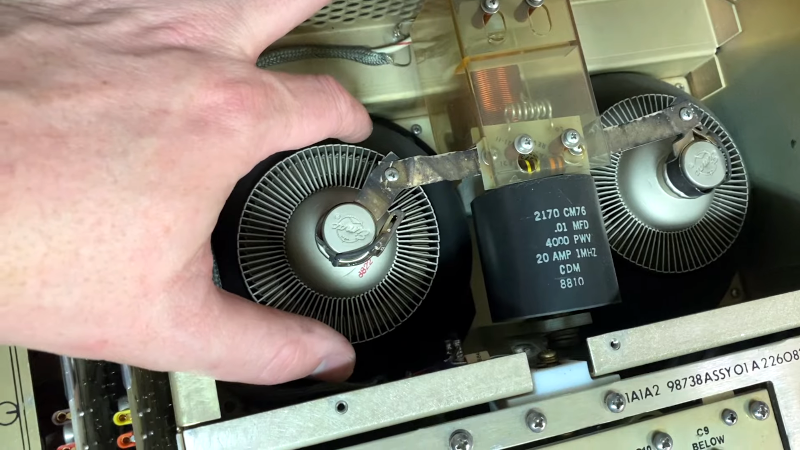If you enjoy old military hardware, you probably know that Harris made quite a few heavy-duty pieces of radio gear. [K6YIC] picked up a nice example: the Harris RF-130 URT-23. These were frequently used in the Navy and some other service branches to communicate in a variety of modes on HF. The entire set included an exciter, an amplifier, an antenna tuner, and a power supply and, in its usual configuration, can output up to a kilowatt. The transmitter needs some work, and he’s done three videos on the transmitter already. He’s planning on several more, but there’s already a lot to see if you enjoy this older gear. You can see the first three below and you’ll probably want to watch them all, but if you want to jump right to the tear down, you can start with the second video.
You can find the Navy manual for the unit online, dated back to 1975. It’s hard to imagine how much things have changed in 50 years. These radios use light bulbs and weigh almost 500 pounds. [Daniel] had to get his shop wired for 220 V just to run the beast.
It is amusing that some of this old tube equipment had a counter to tell you how many hours the tubes inside had been operating so you could replace them before they were expected to fail. To keep things cool, there’s a very noisy 11,000 RPM fan. The two ceramic final amplifier tubes weigh over 1.5 pounds each!
The third video shows the initial power up. Like computers, if you remember when equipment was like this, today’s lightweight machines seem like toys. Of course, everything works better these days, so we won’t complain. But there’s something about having a big substantial piece of gear with all the requisite knobs, switches, meters, and everything else.
We can’t wait to see the rest of the restoration and to hear this noble radio on the air again. You can tell that [Daniel] loves this kind of gear and you can pick up a lot of tips and lingo watching the videos.
















The only Harris transmitters I have worked on were the 100KW AM Harris transmitters at Radio Australia, Shepparton. They were fun to learn as they were unlike the old AWA “normal” transmitters in that the Harris ones used a single ended PA and a PWM modulator, running on around 30KV if I remember correctly.
Fun times!
Looks like the 4CX1000A tubes
I’d guessed something similar. I’ve used the 4CX600J tubes before, and recognise these as the “bigger brother”
Actually, now I’ve looked at the datasheet, they appear to be 4CX1500B tubes
There’s a whole series. But it looks wider than the 4CX250 I had.
I am currently employed as a DOD contractor that manages the repair of this system (yes…..it is still in operation). The PA tubes are originally made by Eimac when the USA still made tubes. James was correct, they are the JAN8660 Tetrodes (4CX1500B is the China PN). This system requires two and we spend about $9k for the pair (through Naval Supply)….. the driver tubes are a matched pair that costs around $8k (NAVSUP). I believe the matched pair tube PN is JAN8122(V)1. I would recommend upgrading/modifying to more modern tech due to the very limited availability of parts and prices. The URT-23 is easy to repair if you had parts that were made in the 60’s and 70’s. Newer versions of parts that are made now use different manufacturing techniques and different materials that aren’t always compatible although the characteristics are the same (interlock shaft/switches, IC’s, Caps, etc). Switch vane flags were made on a four-slide (just spent 10k to have a shop make the tooling for this). A1A9 CCA’s fail a lot. I am constantly buying JANTX2N2222A, JANTX2219A, and the midget fuses from Littlefuse. The original high voltage wire is not rated for the system so we are always replacing it with something rated at 6000v. Lastly, and I cant stress this enough, make sure ALL THE MODULES AND CCA’S ARE COMPATIBLE WITH THE SYSTEM YOU ARE TRYING TO BUILD. There is an extensive chart “compatibility list” for the T-827(series), AM-3924(series) and PP-3916C/D modules and outfitting. My #1 URT-23 subject matter expert is an older gentlemen (sailor) about 75 years old that has been repairing this system for about 40-50 years now. God help me when he decides to leave. Good luck!
I have also a URT-23 unit but it comes without interconnection cables. If you know where I can find them….
Thank you
>everything works better these days
LOL!
I maintained several of these for the Coast Guard Radioman A School in the early 80’s. The most common failure was in the logic boards that drove the tuner section, they used a copper trace board-edge slot-in connector that was not gas-tight, resulting in a resistive or open path. I carried a yellow #2 pencil rub off the copper corrosion, although smacking the outer housing with a rubber mallet was also an option. 😂
Though they’ll never admit it, the US Navy still maintains these dinosaurs on some of their legacy platforms.
I went to repair school on the URT-23B version. The URT-23D is still in service on many surface ships and submarines. These things are a beast. They will output well over the rated 1000 watts. We used to crank them up so they would “peg” the meter hard at 1500 W output. They will run 1000 watts output RTTY 24/7/365.
I was wondering what made my views pop again on YouTube. Thanks for watching. My next video will show the troubles that I have found in the process of activation and the steps I am taking to repair them.
Seeing the photo with the hand on the plate of that tube (valve -Jenny) made a lump form in my throat.
Don’t do that to a rig with power applied!
Tune for minimum smoke!
Minimum